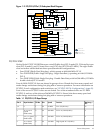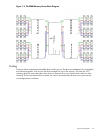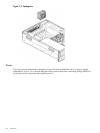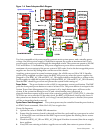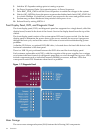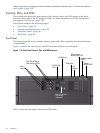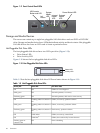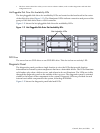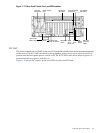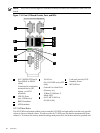• Hard drives
• Cables
• Backplane board
• Core I/O cards
The server can contain up to eight SAS disk drives. The drives have LEDs that indicate activity
and device status, and an LED used to locate each drive. Additionally, there is a set of slot
availability LEDs positioned in the middle of the disk drive bays on the front of the chassis. The
illuminated LEDs indicate connection and power from a SAS controller to the bank of SAS disk
drive slots.
The disk drives plug directly into the SAS backplane board. There is one SAS backplane board
in the server.
Two cables connect from the SAS backplane board to the SAS core I/O card. Service the SAS
backplane board and SAS core I/O card from the top of the chassis.
Firmware
Firmware consists of many individually linked binary images that are bound together by a single
framework at run time. Internally, the firmware employs a software database called a device
tree to represent the structure of the hardware platform and to provide a means of associating
software elements with hardware functionality.
The firmware incorporates the following main interfaces:
Processor Abstraction Layer (PAL) PAL provides a seamless firmware abstraction between
the processor and system software and platform firmware.
System Abstraction Layer (SAL) SAL provides a uniform firmware interface, and initializes
and configures the platform.
Extensible Firmware Interface (EFI) EFI provides an interface between the operating system
and the platform firmware. EFI uses data tables that contain
platform-related information, and boot and run-time
service calls that are available to the operating system and
its loader to provide a standard environment for booting.
Advanced Configuration and Power
Interface (ACPI)
ACPI provides a standard environment for configuring
and managing server systems. ACPI moves system power
configuration and management from the system firmware
to the operating system, and abstracts the interface between
the platform hardware and the operating system software.
This enables each to evolve independently of the other.
The firmware supports HP-UX 11i version 2, June 2006 release, Linux®, Windows®, and
OpenVMS 8.3 operating systems through the Itanium processor family standards and extensions,
and has no operating system-specific functionality included. All operating systems are presented
with the same interface to system firmware, and all features are available to the operating system.
User Interface
The Itanium processor family firmware employs a user interface defined by an HP standard
called Pre-OS System Startup Environment (POSSE). The POSSE shell is based on the EFI standard
shell. Several commands were added to the standard EFI Shell to support HP value-added
functionality.
Event IDs for Errors and Events
The system firmware generates event IDs for errors, events, and forward progress to the iLO 2
MP through common shared memory. The iLO 2 MP interprets and stores event IDs. Reviewing
Firmware 35



